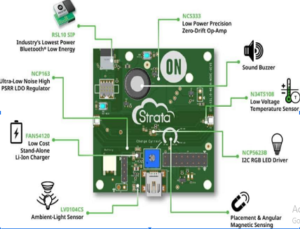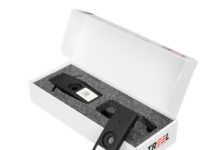
Our world is more interconnected than ever, thanks to the Internet of Things (IoT). As the demand for greater integration of IoT devices grew, the need for an efficient and reliable communication standard emerged. The Bluetooth® 5.0 specification paved the way for the introduction of a number of Bluetooth Low Energy networking features, particularly those that focused on the emerging requirements of IoT applications. Though Bluetooth® 5.0 and Bluetooth Low Energy represented advancements in wireless technology, the inability to support a mesh topology became a significant limitation as the IoT continued to expand. To overcome this obstacle, the Bluetooth Special Interest Group (SIG) launched the Bluetooth mesh Device Properties 1.0 specification, enabling the provisioning of Bluetooth-based interoperable many-to-many communications.
Here, we will explore how mesh networking supports the integration of IoT devices and a solution that helps engineers accelerate designs requiring mesh networking capabilities.
BLUETOOTH® LOW ENERGY MESH NETWORKING
Bluetooth® Low Energy mesh networks implement a many-to-many (m:m) topology and use managed flooding to send data. As a result, they don’t require any centralized routing or routing tables like Ethernet networks. Bluetooth Low Energy mesh specifications also offer built-in security with encryption at multiple layers, so nodes in the network can relay traffic without needing to be aware of the contents of any messages. The nodes can simply pass them along, while potential eavesdroppers on the network only see encrypted packets, a significant benefit for network security while preserving design simplicity. A properly placed Bluetooth Low Energy mesh network can span larger distances than traditional P2P Bluetooth communications as nodes can perform message passing by relaying packets to a destination node out of range of the transmitting node. This enables various IoT applications, including connected lighting and remote sensor monitoring, previously out of range for Bluetooth technology. The mesh specification allows for up to 32,767 nodes, making it well-suited for deployment in a wide range of smart buildings and IoT applications with large numbers of individual devices that need to be connected.
FRIEND AND LOW POWER NODES
One of the most exciting features of a Bluetooth Low Energy mesh network is the ability for certain nodes in the network to operate at significantly reduced power levels—referred to as Low Power Nodes (LPN)—and improve battery life beyond standard Bluetooth Low Energy devices. Low Power Nodes optimize power consumption by only waking up from Deep Sleep intermittently to send and receive data. In order for this to work within a Bluetooth Low Energy mesh network, a Low Power Node must be located near a Friend node, as it cannot function without one. The Friend node stores messages destined for the Low Power Node until that node wakes up to communicate with the rest of the network, at which point, the LPN asks the Friend node for any pending communications and responds to network activity as needed before going back into Deep Sleep.
ON SEMICONDUCTOR RSL10 MESH PLATFORM
While designing a new Bluetooth mesh-based product can be a complicated task, there are tools to help. ON Semiconductor’s RSL10 Mesh Platform is a versatile, easy-to-configure solution for developing mesh networking applications based on the RSL10 Bluetooth 5 radio. The platform includes two RSL10-based Mesh Nodes and a Strata Gateway, which enables connectivity to the Strata Developer Studio™ and acts as the network provisioner so that nodes can be securely added and removed (Figure 1). The Strata Gateway supports seamless and secure connectivity to the Strata Developer Studio. This cloud-connected software enables provisioning of additional mesh networks and firmware-over-the-air (FOTA) updates. Using the virtual workspaces for common mesh networking examples, including a smart office and smart home, developers can access sensor data and trigger settings such as signal strength, ambient light, battery, temperature, and node connections for every node within the network in the Strata basic view. An advanced view allows the user to view several code examples.
Figure 1: The RSL10 Mesh Platform Kit consists of two RSL10 Mesh Nodes and a Strata Gateway. (Source: ON Semiconductor)
With the RSL10 Mesh Platform, engineers can easily implement ultra-low-power mesh networking, using Bluetooth Low Energy technology, and move quickly toward full deployment. Optimized for smart home, building automation, industrial IoT, remote environment monitoring, and asset tracking and monitoring applications, this multi-faceted solution has all the essential elements needed for developing and deploying a mesh network. Alongside the RSL10 System-in-Package (RSL10 SIP), the Mesh Nodes feature multiple environmental sensors for monitoring temperature, ambient light, and magnetic field detection. The nodes also include a 2.3kHz tone indicator, a connector for vibration buzzers, and light dimming and alarm capabilities (Figure 2).
Figure 2: ON Semiconductor RSL10 Mesh Nodes consist of the features required for developing and deploying a mesh network. (Source: ON Semiconductor)
With its best-in-class ultra-low-power consumption, the RSL10 platform is perfectly suited to demonstrate the Low Power Node capabilities of Bluetooth Low Energy mesh. ON Semiconductor’s Bluetooth Low Energy mesh roadmap highlights this by enabling Bluetooth Low Energy mesh Low Power Node functionality on existing RSL10-SENSE-GEVK and RSL10-COIN-GEVB evaluation boards and integrating Friend and Low Power Node behavior into the Mesh Platform Strata user interface.
RSL10 SIP
The RSL10 SIP enables advanced wireless features while optimizing system size and battery life. It is designed for applications using as low as 1.2V batteries, and supports a voltage supply range between 1.1 and 3.3V without external components. The highly-integrated radio SoC features a dual-core architecture and a 2.4GHz transceiver, providing the flexibility to support Bluetooth Low Energy and 2.4GHz custom protocols. The RSL10 is the industry’s lowest power consumption BLE System on Chip; in Deep Sleep Mode only consuming 62.5nW and only 7mW receive power in Receive Mode. The RSL10 also has impressive EEMBC® ULPMark™ scores (1090 ULPMark CP @ 3V; 1260 @ 2.1V).
CONCLUSION
Bluetooth mesh networking opened up the opportunity for the development of many new IoT products. The mesh specification allows for up to 32,767 nodes, making it well-suited for deployment in a wide range of smart buildings and IoT applications requiring large numbers of individual devices to be connected. Using the ON Semiconductor RSL10 Mesh Platform, engineers can accelerate mesh networking development, so that nodes can be more rapidly deployed, which push the performance envelope in terms of range, resiliency, and power budget.
The article has been republished with permission from Mouser Electronics.



















